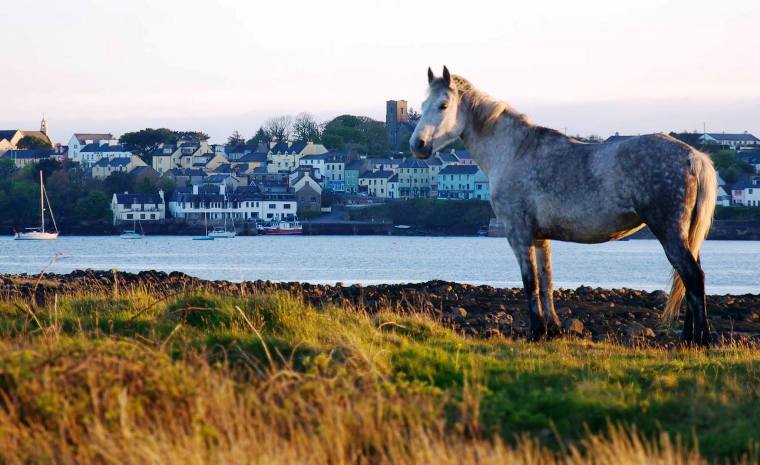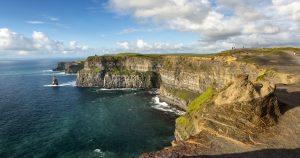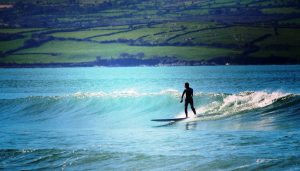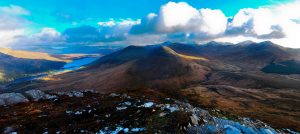
With its lush landscapes, gentle rolling hills and welcoming waters, Connemara is a traveler’s dream destination
I don’t know what it is, but every few years I get itching to return to Ireland and find a really narrow back road in some remote part of the country to drive around on. My wife Linda and I have done some fair damage to our rental cars over the years as a result. Not the drive-it-like-you-stole-it kind – just a lot of scratched paint and the odd ding in rear-view mirrors. We have taken to carrying around a tube of scratch removal paste that we use to buff out the scratches before we return our vehicles. That seems to do the job.
Not long ago, we flew in to Shannon and rented a car that already had a dented mirror and, even before we hit the road, I reminded myself to fold both side mirrors in while going through small villages where the locals park their cars half on the street and half on the narrow sidewalk.
Ireland was as green as I remembered it – even for a dry July – as we drove north towards our destination, a stone house near the shores of Bunowen Bay. We passed through Lahinch, a popular surfing town on the Atlantic. Ireland has become a surf-crazy country in the last decade and attracted surfers from around the world to ride monster waves on offshore ledges in places like Mullaghmore and Easky. The waves in Lahinch were a tad tamer as we travelled through. The town was a bit too popular for my tastes, with a narrow crowded beach packed with pale bodies working on some serious sunburn. I did recall, however, sitting in a pub there one rainy day in February on a previous visit, looking directly out on lads surfing some difficult, but powerful winter waves. So, if and when I return to Lahinch, it will be off season.

The Cliffs of Moher were the next stop, mostly because it was on the way and they were indeed as spectacular as ever. We joined the throngs of tourists from around the world as they stepped out of their buses and cars to make their way to the famed 100 to 200 metre-high-cliffs and stare down at the ocean. An international swarm of teenagers were trying their best to see who could get closest to the edge and I wondered how many people over the years have actually died here. But there’s no denying it is a breath-taking place. In the parking lot, I purchased an obligatory penny whistle and a shillelagh like a good foreign spendthrift. before heading off to Doolin for the first pint of the trip at Gus O’Connor’s Pub. The Guinness tasted equally as good as the one I’d had one here many years before with my old friend Mike. We’d argued that day about James Joyce versus Jack Kerouac like a pair of perfect intellectual idiots while a full Sunday afternoon jam session was taking place with ever-changing fiddle players and new musicians arriving by bus each half hour.
Linda and I spent our first night in a country hotel in Lisdoonvarna, famous for the month-long matchmaking festival that occurs each September when as many as 40,000 lonely-hearts arrive to seek a spouse. For most, it must seem an efficient and tidy way to avoid decisions, dating, dinners, and the complex modern rituals of romance.
In the morning, we were back on the coastal road of the Burren, past Slieve Elva and Black Head. I was particularly taken by the rugged, otherworldly frozen-lava-like limestone formations near Murroogh, and the megalithic tomb at Poulnabrone.
We saved Galway for another day and stayed on the N59 to Clifden, then onto the joyfully twisty and narrow road – more like a paved sidewalk really – leading to our cottage beyond Ballyconneely. The map suggested that much of the peninsula was something called the Roundstone Blanket Bo – not an image that might attract many travellers. But the rocky, pockmarked coastline with its little pure white sand pocket beaches was a dream-come-true for coastal lovers like us.
Across the road from our stone cottage was a fenced in field with a beautiful white horse – a Connemara pony, of course, that most certainly had been a unicorn in a previous incarnation.
 Linda fell in love with the horse immediately and fed him carrots whenever the opportunity presented itself.
Linda fell in love with the horse immediately and fed him carrots whenever the opportunity presented itself.
When we asked about beaches with good waves, folks were strangely tight-lipped. This was a tad puzzling, since most Irish people to whom I asked a question would inevitably tell me much more than I ever wanted to know. But, finally, one hiker we met took pity on us as we poked around sandy coastal trails and told us about a place where the local surfers found favourable waves. It required driving several kilometers through a very large sheep pasture. There were no real roads – just some wheel tracks in the grass and sand, and the sheep were mostly willing to step aside, and if not, you could just drive around them. The beach will go unnamed, but it was exactly what we were looking for – clear blue water, rocky outcroppings on either side, hard packed sand and walloping North Atlantic waves perfectly suited for our inflatable boogie boards and our thirst for salty wet adventure.
On the weekend it was actually quite crowded with local folks, so it wasn’t really that much of a secret, but the mood among camping families was as mellow as a clan gathering of hippy farmers that I once recall attending.
Clifden is the big town near Ballyconneely. The visitors’ website boasts, “Clifden today is a vibrant and cosmopolitan town on the very edge of Europe.” Well, it was a cheerful place with busy people and a few too many shops selling geegaws from China. But the Alcock and Brown Hotel caught my attention, and the two names rang a bell. So I went searching to find out more about those two surnames.
According to National Geographic, “In 1919 Captain John Alcock and Lieutenant Arthur Whitten-Brown became the first pilots to fly nonstop across the Atlantic. They were pioneers and heroes, ushering in the next chapter in the progress of aviation.”
As it happened, the dynamic duo took off from Newfoundland, flew across the ocean, and landed in one of those large Irish bogs just shy of Clifden, thinking it a level and welcoming patch of earth. Though a bit of a crash landing, both men were fine. Alcock told the London Daily Mail that on the trip they had encountered several unforeseen events and that, “The cockpit was very cozy indeed, but when we peered over the side, sleet and ice chewed bits out of our faces.”
Later, wandering the streets of Clifden, I kept wondering why I knew so much about Charles Lindbergh’s later flight across the Atlantic and so little about these two aviation pioneers.
 There is a spectacular drive from Clifden to Knockavally called, appropriately, Sky Road, with some exceptional views of Clifden Bay. We drove on yet another finger of land out towards the Atlantic until we came to Cleggan (Gaelic for skull) where, in 1927, 25 local fishermen were lost at sea in a sudden gale, devastating the town, but later immortalized in poems, songs and stories. The day was slipping away so we didn’t take the ferry to Inishbofin (Island of the White Cow) with its small population 180, a place that was inhabited more than 5000 years ago.
There is a spectacular drive from Clifden to Knockavally called, appropriately, Sky Road, with some exceptional views of Clifden Bay. We drove on yet another finger of land out towards the Atlantic until we came to Cleggan (Gaelic for skull) where, in 1927, 25 local fishermen were lost at sea in a sudden gale, devastating the town, but later immortalized in poems, songs and stories. The day was slipping away so we didn’t take the ferry to Inishbofin (Island of the White Cow) with its small population 180, a place that was inhabited more than 5000 years ago.
On yet another day, we headed south, skirting Roundstone Blanket Bog, and did barefoot hikes of Dogs Bay and Gorteen beaches, ending up in Roundstone, a lovely, slightly touristy town. We had lunch in a little internet café but, upon walking back to our car, encountered an intoxicated band of young men and women in their early twenties along the road. They were goofy, yet polite to us, and I couldn’t quite figure out why the young, somewhat-drunk gentlemen were wearing socks and no shoes. However, the girls were laughing at their antics and they wished us well as we passed.
We found some good mountain hiking in Connemara National Park, not far from Letterfrack, which is Gaelic for Speckled Hill.
Letterfrack was founded by a Quaker couple in the nineteenth century, who moved here and set up a farm to provide food to residents during the Great Famine. After that, Protestant missionaries moved in to convert Catholics to Protestantism, but had little success and gave up after 25 years.
Letterfrack also has a connection to my home province of Nova Scotia, in that it was here that Marconi set up a receiver station for wireless messages coming from Cape Breton, far across the Atlantic.
Further inland along Killary Harbour, called by some “Ireland’s fjord,” is Leenane, home of the Aasleagh Waterfalls on the River Erriff, not far from where it meets the harbour. Nearby, we discovered the Connemara Seaweed Baths, where you can pay a fee to sit in a tub filled with seaweed and saltwater. The clever folks who run the establishment say that their seaweed “is hand cut daily and fresh with essential nutrients and minerals…as well as relaxing tired and aching muscles, saltwater seaweed baths provide a natural cure for skin ailments from psoriasis to eczema and also help relieve associated pain of arthritis and rheumatism.”
 It made me think of the tons of fresh seaweed that washes ashore back home in Nova Scotia going to waste as it rots on the beach instead of being utilized for its curative powers. I made a note to myself to gather up a carload of it after the next storm, empty it into my bathtub, and lie in it for a good hour or two while listening to New Age music.
It made me think of the tons of fresh seaweed that washes ashore back home in Nova Scotia going to waste as it rots on the beach instead of being utilized for its curative powers. I made a note to myself to gather up a carload of it after the next storm, empty it into my bathtub, and lie in it for a good hour or two while listening to New Age music.
Then it was back to boogie boarding at the hidden beach, and a drive to the westernmost tip of our peninsula – Slyne Head. As the road grew yet more narrow and grassy, we were shocked to suddenly come upon a most opulent and worldly Connemara Golf Club.
One of the most curious things about both Ireland and Scotland is that just when you think you are completely off the beaten path and at a most end-of-the-earth locale, you discover a putting green, a mansion-like club house, and men wearing funny hats and baggy pants hitting a little white ball across a perfectly manicured lawn.
There was nothing to do but go into the clubhouse restaurant, which welcomed non-members, for some fish and chips and glass of Kilkenny before another afternoon boogie board session at yet another secluded and unnamed beach.
Sunsets feeding carrots to the Connemara pony across the road became the norm for us. Linda had nick-named him Buddy and he had already grown to like his daily treat by greeting us kindly with a nuzzle on the neck.
Ireland had once again worked its magic on us with barren stone hills, beautiful beaches and, here in Ballyconneely, on a soft summer evening, it seemed impossible to realize that nearly 170 years ago, the entire region was beset by calamity.
On the website connemarahistory.com, the author notes, “In 1845 a fungal disease called ‘blight’ (phythophthora infestans) began to affect the potato crop and led to its failure several years in succession. The British government was slow to react, and this led to mass starvation and disease. Relief schemes were introduced, but these were too late to have any great impact on the situation. Grain continued to be exported, and in one incident grain was left to rot in Clifden port while the population starved.”
 A final day of hiking took us to the Twelve Bens and we found a gravel road heading up into the mountains. Once suitably far from any towns or tourists, we left the car and hiked up through beckoning grass and rock strewn fields filled with free-ranging sheep gossiping about our presence.
A final day of hiking took us to the Twelve Bens and we found a gravel road heading up into the mountains. Once suitably far from any towns or tourists, we left the car and hiked up through beckoning grass and rock strewn fields filled with free-ranging sheep gossiping about our presence.
It was clear that this Connemara that we had grown to know was a hard land in many ways – certainly not an easy place to grow potatoes among the many stones. And its history was beset by tragedies aplenty. But here on the slopes of one of the Bens – we never figured out exactly which one – we were able yet again to leave our own century behind. It was a sunny, oddly windless afternoon filled with small vibrant flowers, growing low to the ground but brilliant in colour, tucked between the many stones.
Perhaps here was another of those “thin places” we had encountered in Sligo and Donegal, a sacred location where the line between the physical world and the spiritual world is diminished to nearly nothing. A place where the magic of the natural surroundings steals your cares away and reminds you that your five senses can provide you with much entertainment and satisfaction, but just beyond your mortal vision is something even much grander. ~ Lesley Choyce




















Leave a Comment